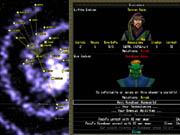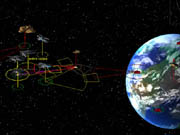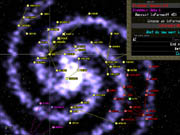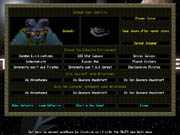Running a galactic empire can't be an easy task, but it's never been more straightforward than in Starships Unlimited: Divided Galaxies. While most space empire games have innumerable ships and colonies to manage, Starships Unlimited strips conventional mechanics down to the essentials. The game runs in real time, but the action stops at each major decision point to let you consider the options; and there's just enough automation of low-level ship and colony tasks that you'd otherwise likely not want to bother with. Despite its sleek design, Starships Unlimited does have a few weaknesses, particularly in its unchallenging AI opponents and generic sci-fi presentation. Even so, because of its fast pace and relatively simple scope, Starships Unlimited succeeds--it's almost like having Risk set in the stars.

Starships Unlimited's polished gameplay isn't a complete surprise, as the game has already had some time to mature in the wild. A shareware version was released at the beginning of 2001, and it attracted a niche following on the strength of its design. The new commercial release greatly improves upon the initially rudimentary graphics and rounds out the game with new sound effects and music. It's available by direct order through the publisher.
The premise of Starships Unlimited is conventional: You're in a position to lead your species from its homeworld to develop an interstellar empire. Up to seven computer-controlled opponents (there's no option for human competition) are simultaneously racing to explore, exploit, and colonize the galaxy. The game ends when one empire conquers all. Unlike more complex games--Master of Orion II and the earthbound Civilization games, for example--there aren't many options for forcing nonmilitary expansion. You won't find complex diplomacy, espionage, or wonder-building elements in Starships Unlimited, and there isn't a hint of story. The only original bit of color to the generic sci-fi setting is dividing species up into two philosophies: "little endian" and "big endian." This programmer joke (each term refers to a data format) is a reminder that Starships Unlimited is the personal work of one man, Andrew Ewanchyna. Even the "Ape" in the ApeZone studio name is from his initials. Ultimately, though, Starships Unlimited benefits from having one designer's focused and uncompromised efforts.
Starships Unlimited's appeal lies in its elegant gameplay. Aggressive early exploration is very important because each planet holds an artifact that's claimed by the first ship to successfully neutralize local defenders. Artifacts range from special ship and colony bonuses and abilities to the items necessary to advance to the higher technology levels. Each explored system can be added to your empire's political boundaries and harvested as a source of resources. Resource routes are only as efficient as their distance to the nearest colony and tech levels of your freighters' drive and carrying capacity. But it's very expensive to colonize new worlds and to build new ships, so it can be quite a challenge to get a flourishing economy going. In typical games, you're not likely to have more than a few colonies and a half-dozen starships. This smaller scale means there's more focus on what ships and planets you do have, as well as less micromanagement overall.

The game's effective automation makes it quite easy to focus on just high-level strategy. Give starships individual commands or fleet commands, and they'll efficiently navigate and engage in combat without your having to watch over every move. As mentioned, the game pauses at major events--an impending battle, empty build queue, research completion, plus a few others--so you'll generally feel well in control of the situation. Even when presented with a series of choices, the automation usually highlights the one it would pick by default--a small detail but one that streamlines simple tasks, like choosing the nearest system for a scout's next exploration mission. At first, watching the competent AI manage your empire in real time is a good way to learn what works, but it is possible to turn off multiple automation options.
Ship combat uses a well-developed tactical system and is one part of the game you may well want to handle manually. Ships gain experience gradually with each engagement, and with experience comes additional tactical maneuvers. At first, ships have the ability to only thrust forward or backward and to rotate, but there's a wide variety of sweeping turns, strafes, and reverse twists that can be unlocked in time--or perhaps with a discovered artifact. A fast, experienced ship really can defeat an otherwise superior enemy with skillful maneuvering--and that's one gauge of success for any game's tactical combat. The rather weak sentinels that guard artifacts on most worlds provide one method to gain experience early on, and later on, pirates make for another target to keep your ships busy in times of peace. These early random battles are repetitious enough to blindly hand off to the competent computer control, but later on, it can be important to at least watch battles to see how your ship technologies are faring against other species' ships.
Researching technologies and configuring ships accordingly is a central part of the game. There are eight weapon families--half short-range, half long-range--to research, but research costs go up dramatically with each new family, which encourages specialization. However, there are defenses for each weapon type, including point-defense weapons, armor, and shields. So there's some incentive to adjust your ship configurations to match up against enemy ships. Artifacts discovered early in the game also come into play by allowing an empire to move from one of the four technology ages to the next--but only when 15 techs have been researched in the current age.

Unfortunately, the technologies don't have much personality. The research screen is a pretty stripped-down affair, with just a color-coded list of techs you can research and a detail screen with some additional information. To get a good breakdown and comparison of weapons' abilities, you have to jump to the game's separate help file. Although starship design and development is the game's key focus, it's tough to see what a ship is capable of outside of battle. A screen of ship statistics might have helped give a better sense of how your ships size up over time, much like how the screen of graphics comparing empires' finances, population, and such helps gauge overall progress.
Starships Unlimited's streamlined mechanics help keep the pacing even and manageable even in the end game. Even when battles occur simultaneously in multiple systems, it's possible to keep track of the action in manual combat mode, since the real-time play drops away to reveal an underlying turn system. Yet playing in real time has the real benefit of keeping the game moving along more gradually, and it's definitely possible to finish a game in a small 50-star galaxy in one long afternoon's sitting. One significant difference between the original shareware release and the new version is that stars are much farther apart, giving interstellar travel a less trivial feel. However, the fastest time setting wasn't adjusted to compensate, so there are times when you'll have to wait for something to happen.
The game's most serious problem is the weak computer opponents. The AI just isn't aggressive, which is a particular problem since early exploration is so important. As a result, AI players often don't find the artifacts necessary to jump from one technological age to another--although they do tend to use heavy-handed espionage to steal them. Even on the medium and high difficulty settings, the AI just isn't as much of a military threat as you'd expect and is apt to falling behind technologically. While experienced players can resort to handicaps, this isn't much of a long-term substitute for a surprising and challenging computer opponent.

Starships Unlimited was gussied up for its commercial release with improved 2D graphics, sound effects, and a musical score. The ship and combat graphics are actually pretty decent, with different starship looks for each species and ship class. The game's audio is somewhat sparse--but not noticeably so--and the music is reminiscent of a calming planetarium session. The interface itself might be of more concern to new players, as the buttons along the top of the screen aren't at all intuitively ordered, but things quickly become clear enough. There are also appropriate keyboard shortcuts for common tasks--a small but often overlooked detail. The biggest shortcoming of the new interface is that the menu boxes aren't movable, and they obscure the galactic map that's used for most planning, which annoyingly forces you to toggle between interface screens.
Starships Unlimited is a game that's as remarkable for its humble shareware beginnings as it is for its elegant design. The commercial version of Starships Unlimited gives a solid boost to production values and some solid gameplay tweaks, and it should give a good game more exposure. Even so, the game is available only through the publisher's Web site and a few online distributors, and it does come with a $40 price tag even for those who paid the full $25 price for the shareware release. The current demo of the game is based on the shareware release, but it does give you a good sense of the core gameplay, which is representative of both versions. It should be of particular interest to anyone who likes the concept of running a space empire but doesn't like micromanagement that typical of such games. It's an interesting approach, and one that fans of space empire games may compare with that of the upcoming giant in the genre, Master of Orion III.